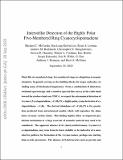| dc.contributor.author | McCarthy, Michael C | |
| dc.contributor.author | Lee, Kin Long Kelvin | |
| dc.contributor.author | Loomis, Ryan A | |
| dc.contributor.author | Burkhardt, Andrew M | |
| dc.contributor.author | Shingledecker, Christopher N | |
| dc.contributor.author | Charnley, Steven B | |
| dc.contributor.author | Cordiner, Martin A | |
| dc.contributor.author | Herbst, Eric | |
| dc.contributor.author | Kalenskii, Sergei | |
| dc.contributor.author | Willis, Eric R | |
| dc.contributor.author | Xue, Ci | |
| dc.contributor.author | Remijan, Anthony J | |
| dc.contributor.author | McGuire, Brett A | |
| dc.date.accessioned | 2022-03-09T19:01:29Z | |
| dc.date.available | 2022-03-09T19:01:29Z | |
| dc.date.issued | 2021 | |
| dc.identifier.uri | https://hdl.handle.net/1721.1/141099 | |
| dc.description.abstract | © 2020, The Author(s), under exclusive licence to Springer Nature Limited. Much like six-membered rings, five-membered rings are ubiquitous in organic chemistry, frequently serving as the building blocks for larger molecules, including many of biochemical importance. From a combination of laboratory rotational spectroscopy and a sensitive spectral line survey in the radio band toward the starless cloud core TMC-1, we report the astronomical detection of 1-cyano-1,3-cyclopentadiene (1-cyano-CPD, c-C5H5CN), a highly polar, cyano derivative of cyclopentadiene. The derived abundance of 1-cyano-CPD is far greater than predicted from astrochemical models that well reproduce the abundance of many carbon chains. This finding implies that either an important production mechanism or a large reservoir of aromatic material may need to be considered. The apparent absence of its closely related isomer, 2-cyano-1,3-cyclopentadiene, may arise from that isomer’s lower stability or may be indicative of a more selective pathway for formation of the 1-cyano isomer, perhaps one starting from acyclic precursors. The absence of N-heterocycles such as pyrrole and pyridine is discussed in light of the astronomical finding of 1-cyano-CPD. | en_US |
| dc.language.iso | en | |
| dc.publisher | Springer Science and Business Media LLC | en_US |
| dc.relation.isversionof | 10.1038/S41550-020-01213-Y | en_US |
| dc.rights | Article is made available in accordance with the publisher's policy and may be subject to US copyright law. Please refer to the publisher's site for terms of use. | en_US |
| dc.source | arXiv | en_US |
| dc.title | Interstellar detection of the highly polar five-membered ring cyanocyclopentadiene | en_US |
| dc.type | Article | en_US |
| dc.identifier.citation | McCarthy, Michael C, Lee, Kin Long Kelvin, Loomis, Ryan A, Burkhardt, Andrew M, Shingledecker, Christopher N et al. 2021. "Interstellar detection of the highly polar five-membered ring cyanocyclopentadiene." Nature Astronomy, 5 (2). | |
| dc.contributor.department | Massachusetts Institute of Technology. Department of Chemistry | |
| dc.relation.journal | Nature Astronomy | en_US |
| dc.eprint.version | Author's final manuscript | en_US |
| dc.type.uri | http://purl.org/eprint/type/JournalArticle | en_US |
| eprint.status | http://purl.org/eprint/status/PeerReviewed | en_US |
| dc.date.updated | 2022-03-09T18:40:28Z | |
| dspace.orderedauthors | McCarthy, MC; Lee, KLK; Loomis, RA; Burkhardt, AM; Shingledecker, CN; Charnley, SB; Cordiner, MA; Herbst, E; Kalenskii, S; Willis, ER; Xue, C; Remijan, AJ; McGuire, BA | en_US |
| dspace.date.submission | 2022-03-09T18:40:34Z | |
| mit.journal.volume | 5 | en_US |
| mit.journal.issue | 2 | en_US |
| mit.license | PUBLISHER_POLICY | |
| mit.metadata.status | Authority Work and Publication Information Needed | en_US |
